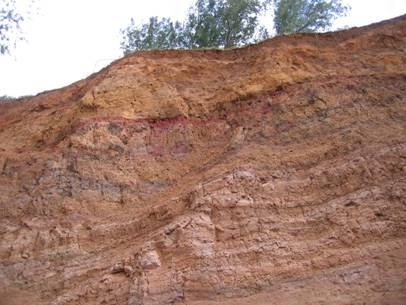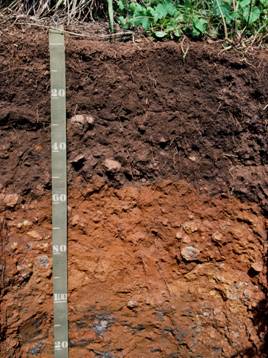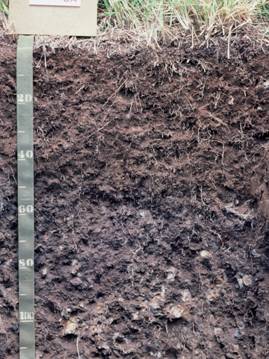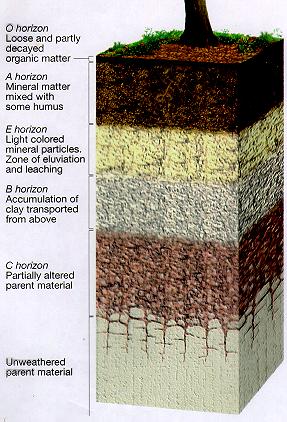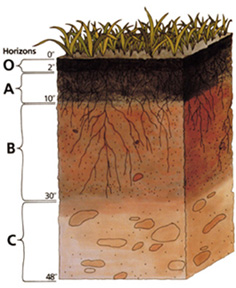
|
|||||
Soil ProfileThe soil profile is an important tool in nutrient management. By examining a soil profile, we can gain valuable insight into soil fertility. As the soil weathers and/or organic matter decomposes, the profile of the soil changes. For instance, a highly weathered, infertile soil usually contains a light-colored layer in the subsurface soil from which nutrients have leached away. On the other hand, a highly fertile soil often has a deep surface layer that contains high amounts of organic matter. With clues provided by soil profile, we can begin to predict how a soil will perform under certain nutrient management conditions. In the previous section, we looked at how soil is actually an integration of water, air, minerals and organic matter. Now we will view the soil as a vital part of the earth’s physical landscape. The world’s soils are like blankets that cover most of the earth’s land surfaces. We could not survive without it since most crops would not be able to grow in the dense rock that lies underneath. There is no uniform depth to our earth’s soils. While it can be absent in places of exposed bedrock, soil may extend up to tens of meters into the earth’s surface. Although this may not seem insignificant when compared to the depth to the core of the earth, the soil profile can be very intricate and diverse. In fact, the soil profile is made up of distinct layers, known as horizons. The five most common horizons are collectively known as the master horizons. Figure 5 below depicts a road cut in Maui which shows the multitude of layers that can exist in soil. Though the soil profiles in Figure 6 belong to two very different soils, both contain distinct surface and subsurface soil layers. Scientists have developed methods to describe the various components and characteristics of the soil profile. By using common terminology, soil profile descriptions are valuable for deciding how the soil might be used and/or predicting how the soil might react to its intended use. Technical descriptions of the soil are not only useful for farmers, but for scientists, ecologists, soil engineers, hydrologists and land use planners.
Figure 5. View of a road cut in Maui. Road cuts are excellent ways to observe the layers, or horizons, within a soil profile. This particular soil profile is well developed and consists of many layers.
Components of the Soil ProfileA soil horizon makes up a distinct layer of soil. The horizon runs roughly parallel to the soil surface and has different properties and characteristics than the adjacent layers above and below. The soil profile is a vertical section of the soil that depicts all of its horizons. The soil profile extends from the soil surface to the parent rock material. The regolith includes all of the weathered material within the profile. The regolith has two components: the solum and the saprolite. The solum includes the upper horizons with the most weathered portion of the profile. The saprolite is the least weathered portion that lies directly above the solid, consolidated bedrock but beneath the regolith. Master HorizonsThere are 5 master horizons in the soil profile. Not all soil profiles contain all 5 horizons; and so, soil profiles differ from one location to another. The 5 master horizons are represented by the letters: O, A, E, B, and C. O: The O horizon is a surface horizon that is comprised of organic material at various stages of decomposition. It is most prominent in forested areas where there is the accumulation of debris fallen from trees. A: The A horizon is a surface horizon that largely consists of minerals (sand, silt, and clay) and with appreciable amounts of organic matter. This horizon is predominantly the surface layer of many soils in grasslands and agricultural lands. E: The E horizon is a subsurface horizon that has been heavily leached. Leaching is the process in which soluble nutrients are lost from the soil due to precipitation or irrigation. The horizon is typically light in color. It is generally found beneath the O horizon. B: The B horizon is a subsurface horizon that has accumulated from the layer(s) above. It is a site of deposition of certain minerals that have leached from the layer(s) above. C: The C horizon is a subsurface horizon. It is the least weathered horizon. Also known as the saprolite, it is unconsolidated, loose parent material. The master horizons may be followed by a subscript to make further distinctions between differences within one master horizon.
The soil profile develops over time as the result of the weathering of minerals and deposition of organic matter. The following link from North Carolina States University provides a brief animation of the horizon development process within the soil profile: http://courses.soil.ncsu.edu/resources/soil_classification_genesis/soil_formation/soil_transform.swf |
|||||
